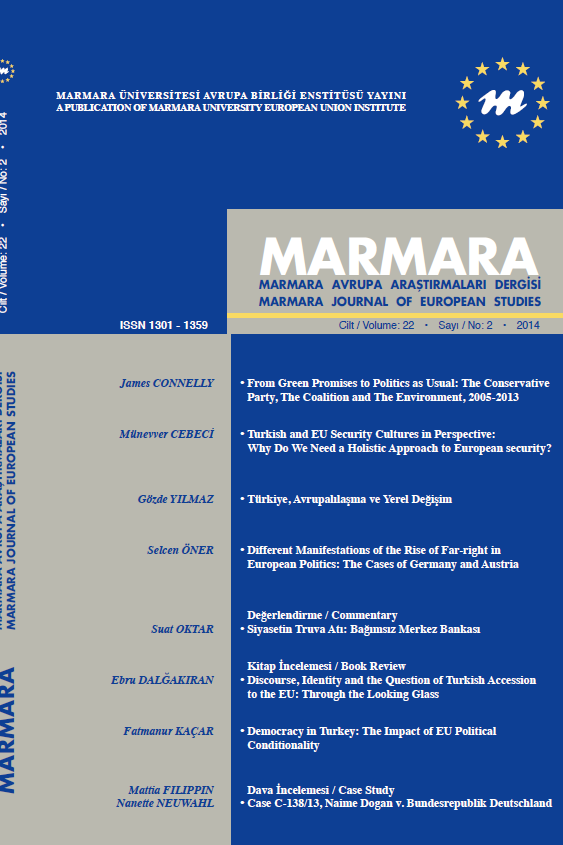IMPACT OF MONETARY AND FISCAL POLICIES ON INCOME INEQUALITY IN EUROPEAN MONETARY UNION
The article investigates the relationship between ECB 's monetary policy, SGP constrained fiscal policies of EMU members, the growth levels and the members' social development pattern embodied as income distribution. Panel co integration analysis is employed for the period between 1999 and 2008 in search for the impact of economic and monetary unification of the first 12 EMU members on the increasing income inequality. The results of the empirical analysis show that both the monetary policy of ECB and the restrained fiscal policies of the EMU members have negative effects on income equality. The findings also suggest that growth has positive effect on income distribution but the pace ofGDP growth is declining in EMU.Keywords: Monetary Policy, Fiscal Policy, Income Distribution, Models with Panel Data
Anahtar Kelimeler:
-
IMPACT OF MONETARY AND FISCAL POLICIES ON INCOME INEQUALITY IN EUROPEAN MONETARY UNION
___
- Bourguignon, F., & Verdier, T. (2000). Oligarchy, democracy, inequality and growth. Journal of Development Economics, 62, 285-313.
- Bulir, A., & Guide, A.-M. (1995). Inflation and Income Distribution: Further Evidence on Empirical Links. International Monetary Fund Working Paper, No. 95/86. Retrieved: September 17, 2008, from http://papers.ssm.com/sol3/papers.cfm?abstract_id=883233
- Cordoba, J. C., & Verdier, G. (2008). Inequality and growth: Some welfare calculations. Journal of Economic Dynamics & Control, 32, 1812-1829.
- Deininger, K., & Squire, L. (1996). Measuring income inequality: a new data-base. World Bank Economic Review, 10, 565-591.
- Deininger, K., & Squire, L. (1998). New ways of looking at old issues: inequality and growth. Journal of Development Economics, 57,259-287.
- Im, K. S., Pesaran, M. H., & Shin, Y. (2003). Testing for Unit Roots in Heterogeneous Panels. Journal of Econometrics, 115, 53-74.
- Keefer, P., & Knack, S. (1999). Polarization, Politics, and Property Rights: Links between Inequality and Growth. World Bank Policy Research Working Paper No. 2418. Retrieved: September 18, 2008, from http:/ /ssm.corn/abstract=632489
- Kuznets, S. (1955). Economic Growth and Income Inequality. The American Economic Review, 45, 1-28.
- Li, H., Xie, D., & Zou, H.-F. (2000). Dynamics oflncome Distribution. The Canadian Journal of Economics, 33, 937-961.
- Lucas, R. E. (2004). The industrial revolution: past and future. The Region, 18, 5-20. Retrieved: September 24, 2008, from http:/ /minneapolisfed.org/pubs/region/04-05/essay .cfm
- Moran, T. P. (2005). Kuznets's Inverted U-Curve Hypothesis: The Rise, Demise, and Continued Relevance of a Socioeconomic Law. Sociological Forum, 20, 209-244.
- Pedroni, P. (1999). Critical Values for Cointegration Tests in Heterogeneous Panels with Multiple Regressors. Oxford Bulletin of Economics and Statistics, Special Issue, 653-670.
- Pedroni, P. (2000). Fully Modified OLS for Heterogeneous co integrated Panels. Nonstationary Panels, Panel Cointegration and Dynamic Panels, 15, 93-130.
- Perotti, R. (1996). Growth, income distribution and democracy: what the data say. Journal of Economic Growth, 1, 149-187.
- Phillips, P. C. B., & Hansen, B. E. (1990). Statistical inference in instrumental regressions with 1(1) processes. Review of Economic Studies, 57, 99-125.
- Pryor, F. L. (2007). The anatomy of increasing inequality of U.S. family incomes. The Journal of Socio-Economics, 36, 595-618.
- Romer, C. D., & Romer, D. H. (1998). Monetary Policy And The WellBeing Of The Poor. NBER Working Paper No. W6793. Retrieved: September 20, 2008, from http://ssm.com/abstract=139571
- Weede, E. (1997). Income inequality, democracy and grow reconsidered. European Journal of Political Economy, 13, 751-764.
- ISSN: 1301-1359
- Yayın Aralığı: Yılda 2 Sayı
- Yayıncı: Marmara Üniversitesi
Sayıdaki Diğer Makaleler
THE APPLICATION OF NEO(NEO)FUNCTIONALIST THEORY TO JUSTICE AND HOME AFFAIRS
TURKISH IMAGE AND ANTI-TURKISH LOBBIES IN EUROPE
THE EFFECTS OF THE CUSTOMS UNION ON TURKISH HOME APPLIANCE INDUSTRY
IMPACT OF MONETARY AND FISCAL POLICIES ON INCOME INEQUALITY IN EUROPEAN MONETARY UNION
İmre ERSOY, Bilgehan BAYKAL, Pınar DENİZ
ENTEGRASYON SÜRECİNDE DİLİN ÖNEMİ: TÜRKİYE'DEKİ ENTEGRASYON KURSLARI
THE AREA OF FREEDOM, SECURITY AND JUSTICE AFTER THE LISBON TREATY
